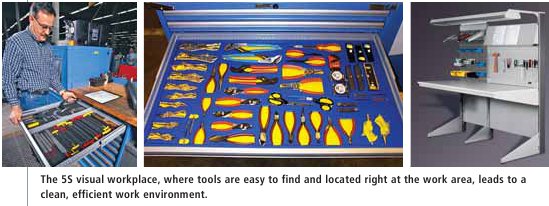Many manufacturing facilities have opted to follow the path toward a 5S workplace organizational and housekeeping methodology as part of continuous improvement or lean manufacturing processes.
5S is a system to reduce waste and optimize productivity through maintaining an orderly workplace and using visual cues to achieve more consistent operational results. The term refers to 5 steps – sort, set in order, shine, standardize, and sustain – that are also sometimes known as the 5 pillars of a visual workplace. 5S programs are usually implemented by small teams working together to get materials closer to operations, right at workers' fingertips, and organized and labeled to facilitate operations with the smallest amount of wasted time and materials.
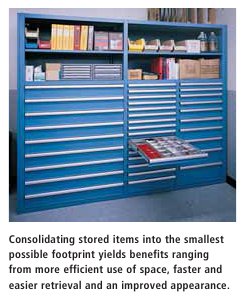
The 5S system is a good starting point for all improvement efforts aiming to drive out waste from the manufacturing process, and ultimately improve a company's bottom line by improving products and services, and lowering costs. Many companies are seeking to make operations more efficient, and the concept is especially attractive to older manufacturing facilities looking to improve the bottom line by reducing their costs.
"A place for everything, and everything in its place" is the mantra of the 5S method, and storage and workspace systems such as those provided by Lista Int'l allow improved organization and maximum use of cubic space for the highest density storage. The result is an improved manufacturing process and the lowest overall cost for goods produced.
The 5 Pillars of a Visual Workplace
Implementing the 5S method means cleaning up and organizing the workplace in its existing configuration. It is typically the first lean method that organizations implement. This lean method encourages workers to improve their working conditions and helps them learn to reduce waste, unplanned downtime, and in-process inventory.
A typical 5S implementation would result in significant reductions in the square footage of space needed for existing operations. It also would result in the organization of tools and materials into labeled and color coded storage locations, as well as "kits" that contain just what is needed to perform a task.
The 5S methodology is a simple and universal approach that works in companies all over the world. It is essentially a support to such other manufacturing improvements as just-in-time (JIT) production, cellular manufacturing, total quality management (TQM), or six sigma initiatives, and is also a great contributor to making the workplace a better place to spend time.
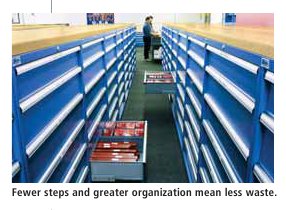
Table 1 (below) provides an overview of the 5 pillars, with a brief definition of what the step means in a manufacturing context, why it's important, and the list of problems it avoids if implemented.
Benefits to the company from using the 5S methodology include raising quality, lowering costs, promoting safety, building customer confidence, increasing factory up-time, and lowering repair costs.
The 5S methodology is typically implemented using a 3-step process, which includes establishing a cross-functional team (including employees that work in the associated areas), touring all areas associated with the manufacturing process under review, and brainstorming on ways to improve organization to reduce waste. For example, factories have more than their share of searching waste. It is not unusual for a 3 hour changeover routine to include 30 minutes of searching. When attempting to reduce changeover time radically (for example, going from 3 hours to 10 minutes), there is clearly no room for 30 minutes of searching waste.
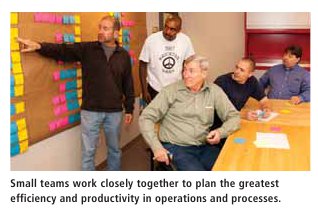
Value stream mapping (VSM) can be used in the 5S process to analyze the material, process, and information flow. The information is used to develop a current state map, which sets out how things have been done in the past. The team then analyzes the current state map to identify opportunities for workplace organization and housekeeping improvements. A wide range of ideas is considered – while all ideas won't end up being viable, all are worthy of investigation. The key is to observe non-value-added processes and create an environment to promote value-added work through waste elimination.
Finally, the team envisions a future state based on the exercise and begins implementing the future state. The process is iterative; the future state becomes the current state, and a continuous improvement process should be used to identify new ways to reduce waste. Waste is defined very broadly, and includes things like waste in the movement of material, carrying too much inventory, defects or rework, producing scrap, waiting or unnecessary motion.
Some examples include waste of motion because the person sent to get a part or tool could not find it; searching waste because no one can find the key to the locked cabinet that contains needed tools; waste of defective products because defective parts were not separated properly and were used by mistake; and even waste caused by unsafe conditions, as boxes of supplies that are left in a walkway, causing someone to trip and get injured.
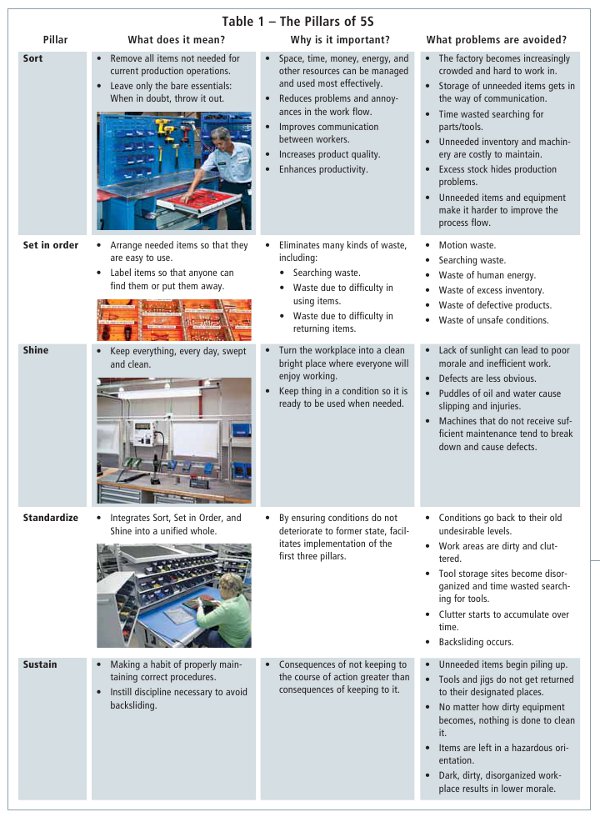
For example, team members might observe workers walking long distances to obtain needed parts, or spending time reaching into bins on shelves to find parts. Or they may identify hardware, like nuts, bolts, and screws that are used in a certain area, but stored in a central storage facility far away from the point of use. The goal of the VSM is for the team to walk the process, and identify what operators really need versus what they receive.
The Role of Storage in the 5S Organization Methodology
As noted, one of the 5S pillars is identifying and eliminating many kinds of waste, including time wasted searching for items, waste due to difficulty in using items, and waste due to difficulty in returning items. Storage solutions play an important part in implementing waste elimination through space reduction, organization improvement, and inventory management. Storage cabinets and workbench products that allow dense storage, a smaller footprint, and visual organization near where the tool is needed, become a key factor in implementing the 5S program.
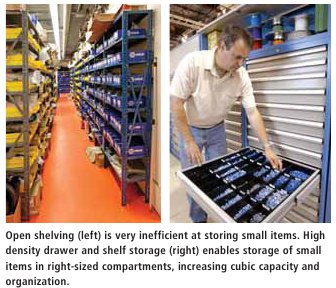
Systems should be set up so everything has a place that is available when needed, including the manufacturing floor, areas where products are being packaged, through the equipment maintenance area. Everything should be labeled and identified. Local storage minimizes travel time, and adjustable storage and workbenches make it easier to adapt to the differing needs of individual employees.
Using Storage Walls organized with bar coded handles can reduce wasted time due to lost inventory and searching. Such systems also facilitate quick tool changes for different product lines. Storing tools next to machines in use rather than in multiple storage locations around the facility can save hours each day.
Modular drawer storage cabinets that allow the maximum use of cubic space for the highest density storage are ideal for high-density storage of parts, tools, and items of virtually any size and type. They are scalable enough to adapt to future requirements, provide maximum weight-bearing capacity, tailored drawer organization, and ergonomic item handling and access.
For example, Lista Int'l, a leading manufacturer of storage and workspace systems, assists companies in implementing 5S methods as part of lean manufacturing programs to drive waste out of manufacturing processes. The Lista products offer waste elimination through space reduction, organization improvement, and inventory management.
Designed to allow dense storage and a smaller footprint, the storage cabinets make it very easy to add flexibility to production lines to facilitate faster turnaround time. The photos illustrate how the proper storage unit meets the number one mantra of a 5S system for a manufacturing facility – a place for everything and everything in its place.
Storage solutions can go a long way to improve using the 5S methodology to improve manufacturing processes, enabling quicker, more efficient production, which contributes to lower overall costs.
